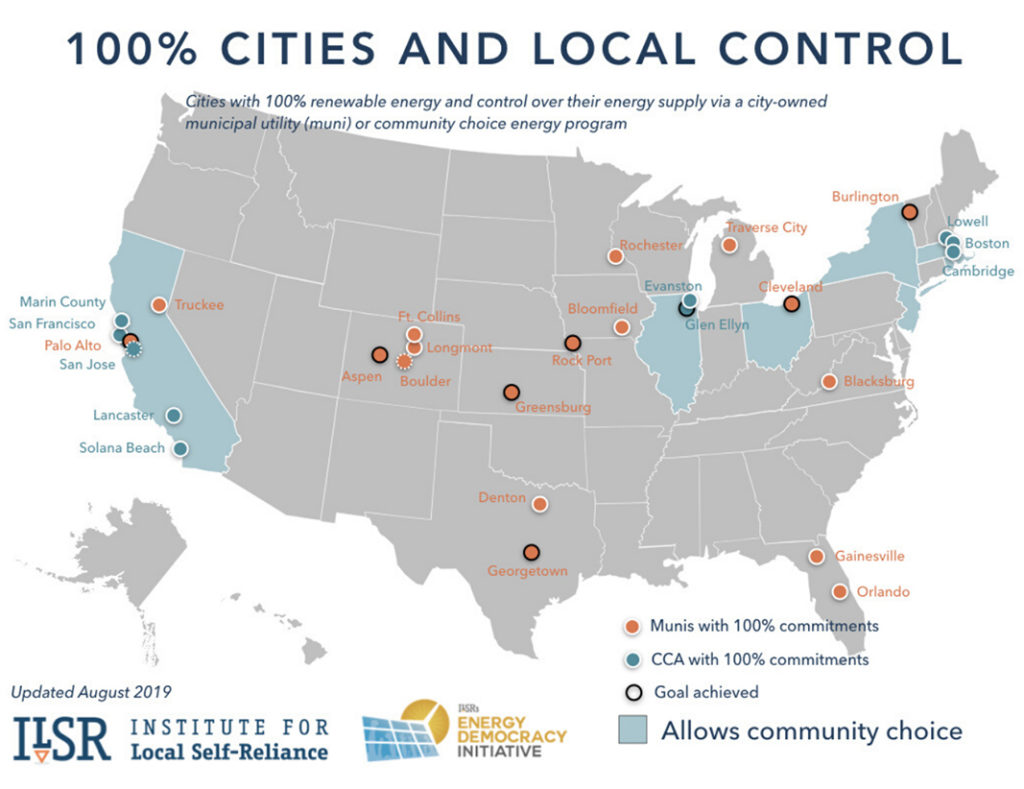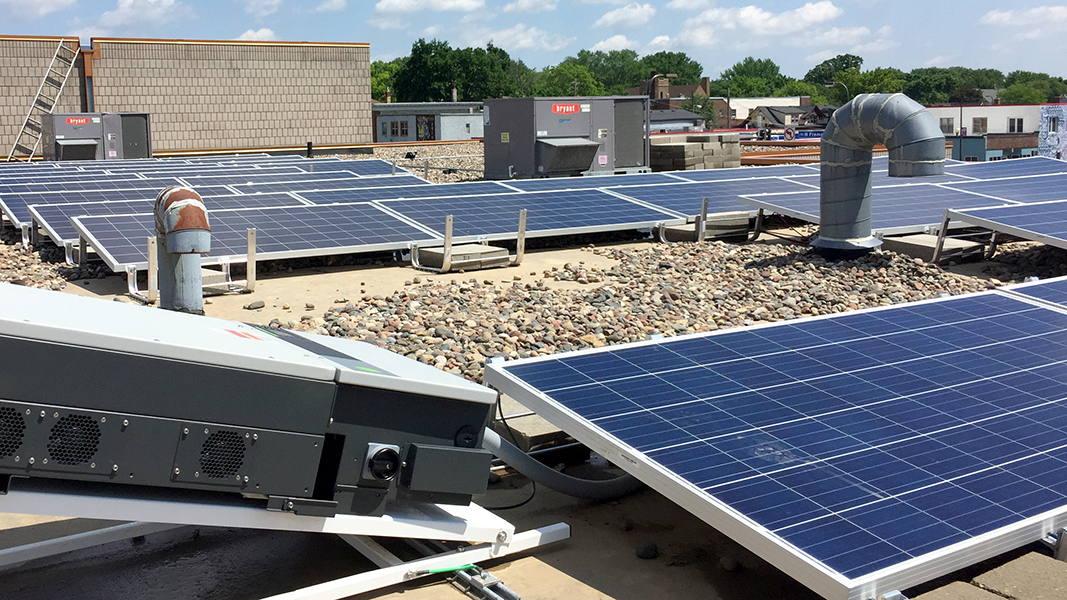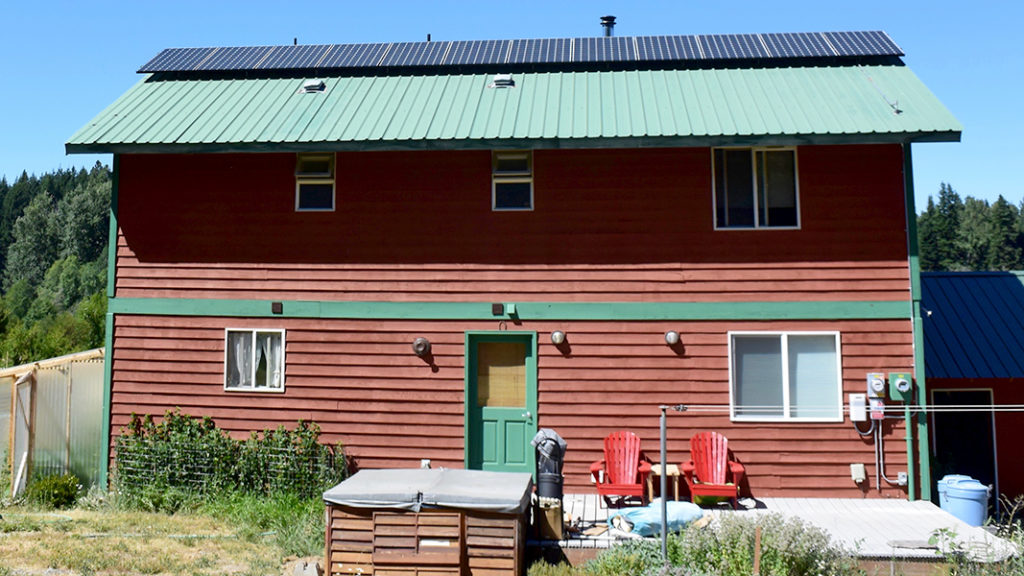Top: Rooftop installation of solar panels on commercial building. Photo courtesy of Institute for Local Self-Reliance
 Sally Brown
Sally Brown
Weekends in Cabo are not the answer to the tragedy that has just hit Texas, tempting as running away might be. The widespread heat, power and water failures in the Long Horn State occurred after record breaking cold temperatures and snow disabled their aging grid. Same thing but different from what happened in California last summer where widespread heat and fires disrupted electricity in that state.
This is climate change — where atypical and extreme weather becomes the new normal. Our aging grid is not up to this task. Going decentralized may be the answer, or at least a significant part of it. For Texas, the most significant part of the failure came from natural gas lines that were too low in pressure and too cold to deliver.
In a state with plenty of sun, there are no statewide subsidies for home solar. Solar makes up a minimal part of Texas’ energy portfolio. Now with the potential to go solar getting less expensive by the week, there are start-ups that also promise the ability to store energy.
As is typical, we folks at BioCycle have already outlined an energy future with decentralization at its core. Step into the way back time machine at BioCycle for a look at what our grid could and potentially should be in my 2017 column, “Grid Lock.” What has happened since I wrote this column four years ago?
- Solar prices have fallen both on a utility scale and a rooftop scale. Utility scale prices are now $0.06/kWh and may go down as much as 19% by 2025. Rooftop scale prices are $0.16/kWh and expected to come down by 16% over the same time period.
- Efficiency of these systems has gone up — from 29.8% in 2016 to 44.5% in 2017, according to the Energy Sage Marketplace.
- Ability to store energy from these systems also seems to be transitioning from a goal to reality. A quick search on line found news articles about community storage in Wisconsin, New York, California and so on.
- Home storage from Tesla can power your Tesla. Tesla is not the only company offering home storage for power from your roof.
Given all these advancements, some might say that it is time for Texas and other parts of the country to really turn the lights on. The critical thing to say is that we have the tools to make a climate resilient grid. That grid is increasingly cost comparable or cost beneficial in comparison to updating our present system. The question is do we have the political will to make a climate resilient grid when doing so involves breaking long-standing relationships with old school providers? This requisite will has been a “won’t” in Texas. I would argue that it is time to make that change. As they say “the answer my friends is blowing in the wind” or “up on the roof.”
To help make the case, we can refresh our memories with a step back in BioCycle time, with these excerpts from “Grid Lock.”
Solar Panels On My Roof
Why wouldn’t you? That is my answer one month into having solar panels on our roof. We had to pay to get it but we get a tax write off. The power is free to us and the excess earns us money (net metering). As the range of green energy options grow and as they become more cost-effective, many more people, companies and utilities are coming to the same conclusion.
According to a report from Lawrence Livermore National Laboratories (LLNL), wind power has increased from just about 11,000 megawatts (MW) in 2007 to over 72,000 MW in 2015 (Mills, et al, 2016). During the same time both utility photovoltaic (PV) and distributed (roof top) PV have increased from close to zero to over 10,000 MW. Each of those MW from wind gives you a carbon dioxide (CO2) credit of over 0.65 metric tons with the equivalent credit from solar over 0.5 metric tons.
And the benefits are not just from greenhouse gas emissions reductions. Both wind and solar reduce nitrogen oxides (NOx), sulfur oxides (SOx), and particulate emissions. Those translate into public health benefits that vary by region but are typically also worth cents per kilowatt hour (kWh). Add those savings up and you are into billions of dollars annually.
LLNL issues an annual “Tracking the Sun” report that follows price trends for solar. The big price reductions in panels happened a few years back. More recent declines in installation prices are less dramatic and are primarily the result of declines in the stuff needed to go with the solar. How much it costs also depends on where you live, who does the installation and how big a system is. Bigger is cheaper and certain states are cheaper than others.
The reductions in costs have also led to a reduction in subsidies. At this point, larger scale wind and solar projects — the kind that utilities or private companies rather than homeowners have — are about the same price to build and operate as conventional power plants. Solar was expected to reach grid parity (same price) as conventional sources in 36 states by 2016, which it did in some states for some projects.
All told, increasing adoption of renewable energy (here with a focus on wind and solar) seems like a done deal, destined to continue to increase every year. Hopefully some day anaerobic digestion will make the big leagues and continue this trend. There is however, one small, potential sticking point, or fly in the optimistic ointment. That is the centralized grid and the utility companies that own and operate it.
Fly In The Optimistic Ointment
Just after we had our solar installed I saw a big headline in the New York Times (NYT), “Rooftop Solar Dims Under Pressure from Utility Lobbyists.” It seems that rooftop solar, which had increased by over 900 percent, was seeing a dramatic slowing in growth. There are several potential reasons for this, including saturation of certain markets and production problems. The one that sent chills down my spine was the focus of the article. Utility lobbyists have been successfully arguing that decentralized or rooftop solar with net metering is just plain unfair.
As a result of this lobbying, several states have decided to phase out net metering and others are considering charging new or higher fees for people that have decided to go solar. Our power utilities have worked with one business model for a very long time and many are reluctant to let that model go. Many utilities are private companies, working under close supervision from state and regional governments. They provide the power and the lines to carry it. In some cases, they purchase the power from large-scale providers. In others, they own the source of the power as well as the distribution system. Green energy, in particular decentralized and multiple sources of energy, means a drastically different business model. In order for renewables to really take hold, this grid and utility structure has to be reimagined and redefined. If this does not happen, we will likely end up with gridlock or at least a much longer and more circuitous road to renewables.
A study done for the Edison Electric Institute compared the current state of electric utilities to the airlines and phone companies before deregulation and innovation completely changed those industries (Kind, 2013). Some of you may remember Ma Bell and Pan Am. Many will not. Distributed solar, privately owned renewables and the range of other factors, of which bioenergy is one small piece, have the potential to result in a massive disruption of the industry as it currently exists. Alternative sources of energy in combination with declining revenues translate to lower profitability for this industry — one that moves slowly and steadily and is accustomed to thinking in 30 year return cycles for capital investments. Put into the larger context, my solar roof represents a major threat to these companies. It is no wonder that many are lobbying against them.
Breaking The Mold
Fortunately not all utilities and not all states are trying to preserve the past. An article in the NYT focused on Green Mountain Power in Vermont. That one made me smile. This utility, which previously had purchased power from a third party, is now focused on creating as many decentralized power sources as possible. The utility, which has been featured in BioCycle, is pushing to include home and local power storage using Tesla’s batteries as part of the utility’s offerings. The ability to store power locally builds resilience during periods of high demand. The utility has also focused on conservation by providing homeowners the tools to monitor their own power usage patterns. Green Mountain has also expanded its own solar and wind generation. Green Mountain is a tiny utility and not representative of most.
ConEd is not a tiny utility, providing service to the New York Metropolitan area. ConEd is also located in New York state, which has the most progressive program to transform the power industry: Reforming the Energy Vision (REV). REV encourages traditional power companies to transform themselves — to “allow third-party businesses to develop and operate distributed resources that would alleviate the need for capital investments.” In English, that means that they would welcome my solar roof. As part of its plan, that is exactly what ConEd has done for neighborhoods in Brooklyn and Queens. As a result of demand growth (something unusual in today’s typical utility profile), ConEd was facing the need to construct new substation feeders and switching to the tune of $1.2 billion. Instead, it encouraged development of non-centralized or DER (distributed energy resources) power and has avoided this new construction and the associated expenses with its Brooklyn Queens Demand Management Project.

ILSR’s Energy For Democracy initiative champions locally-controlled, decentralized renewable energy generation. This map highlights inroads made with municipal commitments, community choice aggregation (CCA) and states that allow community choice.
Other states — Massachusetts, California, Maryland and Minnesota to name a few — have also come up with plans of varying level and forethought to help guide utilities to this new future. Many utility companies are also expanding their portfolios of renewables and their associated business models. Pacific Gas & Electric (PG&E) is one of the leaders. Georgia Power is also looking to capture the future in its business model by offering rooftop solar installations as part of its service model.
Across the industry, there are two paths to the future — one in which the grid is reborn as a sophisticated and interactive smart system and the other where large-scale defection from the grid lets those utility poles collapse from lack of use. While the latter might sound appealing, it can lead to underutilized power and overbuilt infrastructure. What is clear is that the old business plan of providing all the power all the time as a monopoly will not persist.
Sally Brown, BioCycle’s Senior Advisor, is a Research Professor at the University of Washington in the College of the Environment.
References
Kind, P. 2013. Disruptive challenges: Financial implications and strategic responses to a changing retail electric business. Prepared for Edison Electric Institute.
Mills, A., G. Barbose, J. Seel, C. Dong, T. Mai, B. Sigrin, J. Zuboy. 2016 Planning for a Distributed Disruption: Innovative Practices for Incorporating Distributed Solar into Utility Planning Lawrence Berkeley National Laboratory LBNL- 1006047.
Walton, Robert. Pushed by REV, ConEd tests new utility business models in New York. Utility DIVE April 3, 2017.














